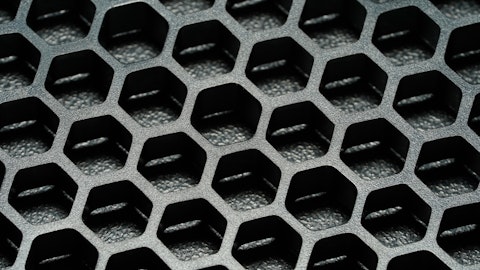Kevin Estok: Got it. Thank you very much.
Operator: Thank you. Our next question comes from a line of Jeff Zekauskas with JPMorgan. Please proceed with your question.
Jeff Zekauskas: Thanks very much. If you exclude Huaibei from both the specialty and rubber black businesses, and I know volume exclusive of Huaibei decreased, but how much did it decrease? What would your volume numbers have been in the two businesses excluding the capacity addition?
Corning Painter: So your question — first of all, good morning, Jeff. So your question is ex-Huaibei, what exactly was our volume? I sort of a little reluctant to go exactly to one site that we’re in startup. The volume impact there is — there’s larger volume in rubber, let me say, than the others. So that they both would’ve been a little bit further negative. But just for commercial sensitivity in China and given the specialties aimed at a few markets in particular, I’d rather not go to quite that level of detail for one quarter.
Jeff Zekauskas: Okay. So let, let’s try it a different way. What was your utilization rate in Huaibei?
Corning Painter: Excellent. So our utilization was around 70%. So that’s a mixture of maintenance that we had in the quarter, that’s a mixture of EPA work, those upgrades as well as just responding to end customer demand levels.
Jeff Zekauskas: And in the fourth quarter we should be at, I don’t know, 90% utilization in Huaibei.
Corning Painter: Well, so we’re — we’ll have some work as we go through the startup and you take some downtime to make this adjustment or that adjustment. So that will impact Huaibei. I think it’ll be less than 90% in the fourth quarter, but loading there would otherwise be quite high. Yeah.
Jeff Zekauskas: And then lastly, can you just give us a feel for what the demand conditions are like in your two businesses in the United States and Europe? In other words if you had to compare the US demand to European demand, are they both the same? Is one weaker or stronger than the other? How do you feel about it?
Corning Painter: Right. So first of all, Jeff, let me go even broader and throw in China. I don’t think demand is really robust in any of those three markets right now. So you’re kind of talking about what’s the — yeah, it would in — within a pretty so-so environment, how do you scale the two? I’d say rubber’s a little bit stronger in North America. Perhaps because Europe’s seen a little bit more in terms of tire imports. I’d say specialty is — I’d say it’s really soft in both. And it depends a little bit. You have to start getting into end segment by end segment and that can shift around quarter to quarter.
Jeff Zekauskas: So in specialty, which is weaker, the United States or Europe.
Corning Painter: So which one is weaker? I would say again, on tire, I think rubber is a little bit weaker in Europe than it is in North America. Specialty between the two, I would say they’re both quite weak. Probably Europe is a little bit weaker than North America.
Jeff Zekauskas: Okay. And lastly, your CapEx is 175 to 200. Like can you even get to 175 given your spending through the first nine months?
Corning Painter: Yeah, Jeff, good question. So it’s considerably backend loaded and we’ve backed it off a bit just in timing or a lot of the timing is regarding to La Porte. So I think that we will see a number of large purchases left this quarter and that will get us there and some of the underspend, right, is going to shift over into next year.
Jeff Zekauskas: All right. Thank you very much.
Operator: Thank you. Our next question comes from the line of Kyle Mowery with Grizzly Rock Capital. Please proceed with your question.
Kyle Mowery: Good morning Corning, Jeff and Wendy. Two related questions for me within your conductives business on PRINTEX Kappa, can you frame out the potential incremental EBITDA contribution relative to the recent announcement? And then secondly, how does this PRINTEX Kappa EBITDA relate to the La Porte, Texas? Because this is in addition, right? Just wanted to make sure it’s not a shift, but rather a growth.
Corning Painter: Yeah. So we expect, let’s say, in the three-to-five-year time period that this would contribute, let’s say, $5 million, $10 million of EBITDA to us. It is a different product than what we’re going to make in La Porte. It’s aimed at a different segment in the marketplace, so it’s really complimentary. Now, a lot of battery companies have a wide range of materials, so it all does help to make us a bit more relevant to these folks, but really see it as a separate marketplace.
Kyle Mowery: Excellent. Thank you.
Operator: Thank you. Our next question comes from the line of Jon Tanwanteng with CJS Securities. Please proceed with your question.
Jon Tanwanteng: Hi, thank you. Just to follow up on the CapEx, did you push — what was the amount that’s pushing out into 2024, number one? And number two, can you give us a preview of what your overall CapEx plan is for next year and just kind of what’s growth, what’s maintenance, that would be very helpful. Thank you.
Corning Painter: Sure. I would expect like $20 million to $30 million to push into next year at this point we’re expecting for this year. If we think about next year, we’ll have maintenance capital in a similar range, let’s say around $90 million. And I would expect almost the vast majority of our growth capital really to be La Porte for next year. And so that would right there get you, let’s say, in the $200 million range, I’d say. Plus we may have to make the adjustment depending upon how much pushes over from one year to the other. Does that get all of your questions, Jon?
Jon Tanwanteng: Yeah. And the pushed out piece was — that wasn’t EPA spending, was it? Or is it something else?
Corning Painter: No, no, no, no. It is mainly about when you place orders for big pieces of equipment that are going to go to La Porte.
Jon Tanwanteng: Understood. Thank you. And then second, I think you gave a metric on rubber getting back up well above 400 per ton on a gross profit basis in Q4. Did you give something similar on specialty that I don’t recall if you said so.
Corning Painter: No, we didn’t because like mix there is a much more dynamic market for us and the whole power play, so I think we’ll have to see where that ends up.
Jon Tanwanteng: Okay. Do you have a directional expectation?
Corning Painter: Yeah, I think it is probably improving from where we are right now. Yeah.
Jon Tanwanteng: Okay. Great. Thank you guys.



